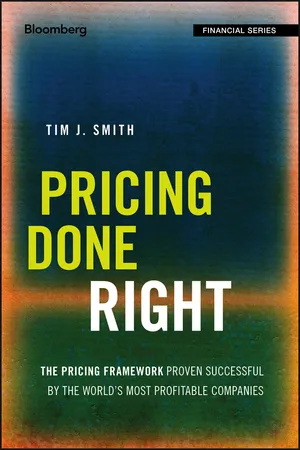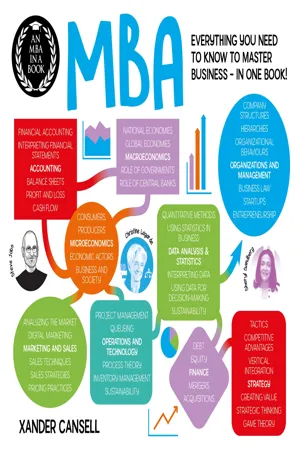Marketing
Pricing Strategies
Pricing strategies refer to the methods and approaches used by businesses to set the prices of their products or services. These strategies can include penetration pricing, skimming pricing, value-based pricing, and competitive pricing, among others. The goal of pricing strategies is to maximize profits, gain market share, or create a competitive advantage.
Written by Perlego with AI-assistance
Related key terms
Related key terms
1 of 4
Related key terms
1 of 3
10 Key excerpts on "Pricing Strategies"
- eBook - ePub
- Paul Reynolds, Geoff Lancaster(Authors)
- 2005(Publication Date)
- Routledge(Publisher)
Marketing management should devise a pricing strategy that is compatible with strategies attached to other elements of the marketing mix. It is not always possible to set a price and apply this rigidly to all customers in all market situations. A pricing strategy denotes how a company will price its products at particular periods of time or particular market conditions. Demand-orientated pricing sets a base price that the company must endeavour to achieve, but it assumes that price be modified in line with changes in demand. Manufacturers must realise that customers are not the same. Some will purchase greater quantities than others, or be situated in areas that are more costly to reach.If a target-return-on-investment price is set, this may only be appropriate during the maturity stage of the product life cycle that was explained in the last chapter. During introduction or growth, it is often necessary to employ a pricing strategy that will enable the target return to be achieved over the long term.A company’s ability and willingness to formulate Pricing Strategies is a reflection of its willingness to adapt and modify price according to the needs of customers and market conditions.7.6.1 Discounting
The discount structure a company employs is a major element of pricing strategy and an indicator of the firm’s flexibility. If customers buy products in large quantities, they may reasonably expect to be charged a lower price than that charged to smaller purchasers. The seller may also offer discounts voluntarily in order to encourage large orders that facilitate economies of scale and assist effective production planning. Such quantity-related discounts can refer to individual orders or be based on an estimated off-take that is planned over a given period. In certain markets, price discounting is important. Day and Ryans (1988 ) say that if used with imagination and creativity they can provide a firm with a strong competitive advantage.Manufacturers can offer discounts to encourage sales of a new product or accelerate demand for a product whose stocks are high, owing to seasonal or cyclical demand variations. In the production context, it is desirable that a constant rate of output is maintained. If market conditions are not conducive to this, a price modification by means of discounting might encourage sales sufficiently to counteract variations in levels of demand. - Ray Donnelly(Author)
- 2010(Publication Date)
- Routledge(Publisher)
CHAPTER 4 Pricing, Pricing Concepts and Price Setting
DOI: 10.4324/9780080961255-5Learning Outcomes
By the end of this chapter you will be able to:- Analyse the role of pricing in influencing customers
- Evaluate and apply a range of pricing approaches and strategies
- Examine the factors that influence the pricing of goods and services, in both domestic and international markets
Introduction
Pricing will now be considered with a view to deepening the understanding of the impact that a variety of Pricing Strategies can have on the product position in the market. We will explore the ways in which pricing can be used to manage the product at various stages in its lifecycle in order to maximise the appeal of the product and profitability.Readers will be appraised of the importance of setting pricing objectives as a benchmark and to guide strategic product development. The role of the customers’ view of different strategies will also be considered particularly in terms of the perception of value for money over which Pricing Strategies have significant influence. The role of pricing in building market share will also be considered as a key elemention the marketing mix.The Role of Pricing in Product Management
Price is ‘the amount of money charged for a product or service’ (Armstrong and Kotler, 2006 ). It is the value that someone is prepared to pay for the product. It is also the one element of the marketing mix that generates revenue, income and profit for the organisation, i.e. it has a direct impact on the bottom line and needs careful management.While organisations do not compete with each other on price alone, it can be an important consideration for the consumer when choosing to make a purchase. Different organisations selling a (very) similar product can charge different prices, which are often brought about by internal calculations of ‘cost’. Different costing approaches will make a difference to the price which can be charged to the consumer if an acceptable profit is to be made by an organisation.- eBook - ePub
Pricing Done Right
The Pricing Framework Proven Successful by the World's Most Profitable Companies
- Tim J. Smith(Author)
- 2016(Publication Date)
- Wiley(Publisher)
CHAPTER 4 Pricing StrategyThere are four pricing decisions that senior executives face in the strategic pricing area. These strategic pricing decisions require executive attention because, as an input, the actual Pricing Strategies chosen need to be aligned with the chosen business strategy to exploit or enable the development of the firm’s relative competitive advantage, and, as an output, the information gathered in developing these Pricing Strategies informs the range of business strategies that may be successful.These four pricing strategy issues are:- Price positioning
- Price segmentation
- Competitive price reaction strategy
- Pricing capability
Each of these strategic pricing decisions is directly dependent on and influences the firm’s business strategy including the customers it serves, its competitive engagement, and its company strength. As such, they deserve senior executive—if not boardroom—attention and should engage the entire executive suite. Rather than having pricing reactions drive their business, leading firms are using their business strategy to proactively drive their pricing strategy.Price positioning directly reflects the firm’s customer acquisition strategy in light of its competitive and company strategy. Price segmentation drills down into the firm’s customer strategy while also reflecting its corporate capabilities. Competitive price reaction strategy is a direct consequence of the firm’s competitive strengths. And pricing capabilities and their development are a direct consequence of the firm’s company strategy aligned to all other strategic business issues.There are many other pricing questions of merit, such as the specific prices to put on specific offers or the pricing of specific transactions. These managerial pricing decisions are extremely important, but they should be made to align with the above pricing strategy decisions rather than having a pricing strategy that is determined by individual managerial pricing decisions made on a daily ad hoc basis. - eBook - ePub
- Geoffrey Lancaster, Lester Massingham(Authors)
- 2017(Publication Date)
- Routledge(Publisher)
3 We can also see that, according to the precise objectives, we might arrive at very different prices for our product and services. Where a company has multiple objectives, Pricing Strategies may need to consider tradeoffs between different possible price levels, such that these different objectives are met.In addition to these broader corporate objectives, pricing decisions must also reflect and support specific marketing strategies. In particular, Pricing Strategies need to be in line with market targeting and positioning strategies, which were outlined in Chapter 3 . Clearly, if a company produces a high-quality product or service aimed at the prestige end of the market it would not be sensible to set a low price even if cost efficiency allowed this. Pricing, therefore, must be consistent with the other elements of the marketing mix and the selected positioning strategy. Effectively, the selection of company and market objectives, market targets and the formulation of a positioning strategy constrain or delineate the range of Pricing Strategies and specific price levels.An example of how price must reflect and support the overall positioning strategy of the company is the price set for the Aston Martin DBS. The car is positioned at the top end of the market and with just 500 made in the UK for sales worldwide the emphasis is on exclusivity. Many people still associate Aston Martin with the character James Bond, emphasizing the racy and prestigious image intended. Prices start at £160,000.Demand considerations
A key parameter affecting pricing decisions is customer based. The upper limit to the price to be charged is set by the market, unless the customer must purchase the product and we are the sole supplier. In competitive markets, demand – that is, the price customers are willing and able to pay – is a major consideration in the selection of Pricing Strategies and levels. It is in the analysis and interpretation of demand and demand schedules - eBook - ePub
The 30 Day MBA in Marketing
Your Fast Track Guide to Business Success
- Colin Barrow(Author)
- 2016(Publication Date)
- Kogan Page(Publisher)
7
Pricing
- Understanding the economics of demand
- Assessing market structures
- Recognizing the components of cost
- Break-even analysis
- Strategic pricing options
- Identifying unprofitable products and services
Business schools, as you might expect, take the subject of pricing very seriously; their elevated fee structures confirm this. None more so than at the Wharton School, University of Pennsylvania, where Jagmohan S Raju, a leading authority on competitive pricing strategy, resides as Joseph J Aresty Professor. Here students spend the equivalent of four full days systematically studying Pricing Strategies designed to capture maximum value, under all types of market conditions. These include complex situations such as pricing new products, products with short life cycles, dynamic pricing, and where products and services are bundled together into a single proposition. Professor Raju contrasts the systematic approach he and professors at other business schools take with the ad hoc or trial-and-error approach to pricing taken by most businesses, which his research shows can significantly reduce a firm’s bottom line.For the MBA student, pricing straddles a number of academic disciplines. Economics provides the big picture, a macro, external overview of factors that affect demand, including the nature of the market and competitive structure the firm faces. Accountancy provides the micro framework for understanding the characteristics of a firm’s cost structure, how that changes with changes in volume and consequently how to set target prices to achieve desired profit goals. Marketing strategy is used to provide frameworks for determining pricing policies and procedures. Finally, a blend of all these disciplines can be used to eliminate products and services that are unlikely to achieve price levels that will meet profit goals. - eBook - ePub
Entrepreneurship Marketing
Principles and Practice of SME Marketing
- Sonny Nwankwo, Ayantunji Gbadamosi, Sonny Nwankwo, Ayantunji Gbadamosi(Authors)
- 2020(Publication Date)
- Routledge(Publisher)
Chapter 8Choosing the right pricing strategy
P. Sergius KokuINTRODUCTIONLEARNING OBJECTIVESAfter reading this chapter, you will be able to:Develop an appreciation for complexities in pricing;Develop pricing objectives;Develop appreciation for the interface between pricing decisions and law;Develop appreciation for the internal and external factors that affect pricing decisions;Be able to discuss pricing variables and the various pricing objectives;Understand the differences in the pricing process in SMEs and large organisations;Choose an appropriate pricing strategy;Be able to do simple calculations involving markup and break-even volume.Regardless of firm size, pricing is one of the most critical activities that take place within the firm. The importance of the pricing process to a firm lies in the fact that pricing is the only means through which a firm can generate revenue. A mistake in the process could be costly to the firm. Pricing mistakes may not only make the firm less profitable but also they can result in a firm’s bankruptcy and its eventual closure.Because of its importance, pricing has attracted a significant research effort in many academic disciplines such as marketing, economics, and law. Because it can be easily mimicked by competition, firms do not rely solely on price for their competitive strategy. However, price’s uniqueness as a strategic tool is reflected in the fact that it is about the only corporate activity that goes by several different names, depending on the context. For example, it is referred to as a ‘fare’ in the transportation industry, a ‘fee’ in education and its related business, ‘cover’ in the entertainment industry, and ‘price’ in many other situations.Regardless of what it is called, the primary objective of price is to cover all the costs incurred in making a product/service and to produce profit while it still appeals to the intended target market. The issue of whether products or services must be priced to maximise profit is a seemingly simple but in fact rather vexing one and will not be discussed in detail here. However, suffice it to say that, while some economists believe that pricing must be used as a tool to maximise profit, behavioural economists take the view that profit maximisation is not the object of the firm. Cyert and March (1963), for example, have argued that because of the interactions that take place within firms, the wide range of personal objectives that are held by the employees, as well as the constraints that exist, firms aim to achieve profits that would be satisfactory to their disparate stakeholders, instead of trying to maximise profits. - eBook - ePub
Pricing and Profitability Management
A Practical Guide for Business Leaders
- Julie Meehan, Mike Simonetto, Larry Montan, Chris Goodin(Authors)
- 2011(Publication Date)
- Wiley(Publisher)
By taking a fact-based approach, companies can not only better align their pricing and overall business strategies, but also address a broad range of common pricing-related problems. Analyses of historic transaction data, marketplace and competitor information, customer profiles, and other information can alert pricing executives to critical issues and their potential impact on strategic goals (which may focus on revenue, profitability, market share, or other objectives). Management can then assess the probable effect of corrective actions before actually implementing them. Later in this chapter we will outline the types of analyses that can be used to help companies develop robust Pricing Strategies.Ensuring Alignment of the Pricing Strategy with Overall Corporate Objectives and Functional StrategiesEvery organization needs to develop a tailored pricing plan that reflects not only its unique competitive position, but also its overall business strategy. An organization's stated goals may be to maximize revenue, to improve profitability, to increase market share, or some combination of the three. The pricing strategy, then, should be clearly aligned with these objectives. It may seem obvious, but if both the pricing plan and the overall business strategy are not documented and communicated, then conflicts may easily arise in daily decision making when the plan and strategy become operational.Managers may assume, for instance, that prices should be set to maximize profitability when in fact the company's higher priority is to increase market share. Even if the market-share goals are short term (due to, for example, a product launch or a specific competitive threat), the pricing leaders must still be aware of them so that processes, guidelines, and metrics can be adjusted to support the overall business objectives. For this reason, companies should generally include senior corporate executives when developing the pricing strategy, which should be regularly evaluated and revised to reflect evolving corporate goals.The plan must also be aligned with the objectives and strategic plans of specific functions. For example, Marketing's projected spending and campaign activity should support the revenue, profit, and volume goals of the pricing strategy. Similarly, Sales' incentives and planning should be aligned with the overall pricing objectives, so that sales representatives can reinforce these goals with every deal. - eBook - ePub
- Marilyn Stone(Author)
- 2007(Publication Date)
- Routledge(Publisher)
9 PRICING
LEARNING OBJECTIVES
When you have completed this unit, you should be able to:- identify the links between economic, accounting and marketing orientations to pricing;
- evaluate the importance of relating pricing decisions to other elements of the marketing mix;
- list the factors which influence price;
- discuss the ways in which firms set prices for the first time;
- appreciate how firms respond to price changes by others;
- understand the increasing importance of IT and the contribution of the Internet to pricing decisions related to online shopping;
- distinguish the differences between pricing for industrial and consumer markets.
INTRODUCTION
The price of a product or service will determine how consumers perceive it, reflect on its brand positioning, influence the choice of marketing channel, affect how it is promoted and have an impact on the level of customer service expected by target customers. The price ingredient of the marketing mix will also affect the viability of the supplying organization. The concept of pricing is complex and of fundamental importance to the successful implementation of a marketing strategy.Pricing is one of the most important elements of the marketing mix, as it affects profit, volume and share of the market and consumer perceptions. Just as pricing plays a crucial role in determining brand image, increasingly companies are being judged on the transparency and equity with which they treat price as a marketing variable.Generally, it is acknowledged that pricing decisions are the most difficult to make because of the complexity of the interaction between three groups involved in the marketing process: consumers, the trade and competitors. In addition pricing decisions often have to be made quickly and with limited, or even no, test marketing. They almost invariably have a direct effect on profit.Among consumers, price is the principal determinant of choice. Its significance is further emphasized by price being the only element among the four marketing mix components that generates revenue – the others produce costs. - eBook - ePub
Marketing and the Customer Value Chain
Integrating Marketing and Supply Chain Management
- Thomas Fotiadis, Dimitris Folinas, Konstantinos Vasileiou, Aggeliki Konstantoglou(Authors)
- 2022(Publication Date)
- Routledge(Publisher)
high-low pricing according to which products are sold at relatively high prices, but at regular intervals, the same products are sold with promotional reductions.Added-value pricing
In added-value pricing, the business tries to differentiate its position against the competition, enhancing the product with a characteristically high value in order to avoid classifying its product as a common good (Armstrong & Kotler, 2009; 2017). In this way, the business tries to maintain or even increase customer loyalty toward it, which will allow it to assign a higher price and secure a satisfying profit margin.Marginal economic analysis
According to the marginal economic analysis, the business must determine the price at the level which maximizes profits (Perreault et al., 2012; Siomkos, 2004). It recommends the right pricing method according to the economic theory by investigating demand – that is, expected income – and the total cost of production and availability of the product at the same time. Thus, this method is based on the combination of demand and cost. It presupposes as much as possible the most precise and reliable estimation of the demand function on the price of the product, which depends especially on the market type and from which arises the total revenues function on the produced and available quantity of the product. Estimation of the total cost function on the quantity of the product is also required.Then, from the functions of total revenues and total costs, the functions of marginal revenue and marginal cost on the product quantity is calculated, respectively. The marginal revenue curve has a negative (descending) slope whereas the marginal cost curve has a positive (ascending) curve. The point at which the marginal revenue and marginal cost curves meet shows the best combination of price and quantity where the company can maximize its profits. In practice, the optimal production quantity can be calculated by equalizing the functions for marginal revenue and marginal cost; then, based on the demand function, the selling price of the product is estimated, which corresponds to the optimal production quantity (Figure 2.9 - eBook - ePub
An MBA in a Book
Everything You Need to Know to Master Business - In One Book!
- Xander Cansell(Author)
- 2023(Publication Date)
- Arcturus(Publisher)
Cost-based pricing is often used when the manufacturer of a product also retails the product. Cost-based (or cost-plus) involves adding the production costs to a fixed profit margin to decide the final price of the product.Markup pricingMarkup pricing is a kind of competitive pricing. It involves a set percentage, the markup, being added to the wholesale product cost.Demand pricingDemand pricing can also be known as customer-based pricing . A retailer uses data about consumer demand to determine the price that should be set.An umbrella’s perceived value is largely dependent on the weather.Pricing practices and segmentation
There are many different pricing practices that companies can use to maximize the number of customers they attract and increase their profitability.Price segmentation is the differentiation of prices for a product (or subsets of a product) based on the maximum amount they are prepared to pay. Because different customers can have different levels of price sensitivity, it allows a business to offer a range of prices for the same, or similar, products, which in turn means they don’t lose out on the more price-sensitive consumers.PSYCHOLOGICAL DIFFERENTIATION VALUEPsychological differentiation value is the amount of innate satisfaction a product gives a consumer when compared to another. For example, a Ferrari has greater psychological value than a Fiat because it’s a faster, better-engineered car and a higher status symbol.Although difficult to quantify directly, psychological differentiation value can be measured through surveys, testing or other indirect methods.Communicating value
The key to price management is communicating value . This means making sure that the differentiating benefits of a product are communicated in monetary terms. A company needs to establish the value provided to the customer early in the transaction and link it directly to a monetary price.Consumer perceptions
A consumer’s concept of quality and value for money come from the consumer’s perception of price. Consumers will often assume that a higher price means the product is higher quality, but equally that it involves a greater sacrifice in terms of money spent. The trade-off between these two perceptions results in perceived value. As this increases, so does willingness to buy.
Index pages curate the most relevant extracts from our library of academic textbooks. They’ve been created using an in-house natural language model (NLM), each adding context and meaning to key research topics.
Explore more topic indexes
Explore more topic indexes
1 of 6
Explore more topic indexes
1 of 4









